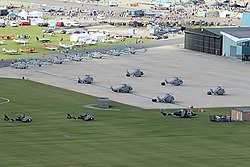RNAS Yeovilton (HMS Heron)
| RNAS Yeovilton | |||||||||
|---|---|---|---|---|---|---|---|---|---|
| Yeovilton, Somerset | |||||||||

RNAS Yeovilton Airshow in 2006
|
|||||||||
|
Location in Somerset
|
|||||||||
| Coordinates | 51°00′31″N 002°38′16″W / 51.00861°N 2.63778°WCoordinates: 51°00′31″N 002°38′16″W / 51.00861°N 2.63778°W | ||||||||
| Type | Royal Naval Air Station | ||||||||
| Site information | |||||||||
| Owner | Ministry of Defence | ||||||||
| Operator | Royal Navy | ||||||||
| Garrison information | |||||||||
| Current commander |
Commodore Jon Pentreath | ||||||||
| Airfield information | |||||||||
| Identifiers | IATA: YEO, ICAO: EGDY | ||||||||
| Elevation | 23 metres (75 ft) AMSL | ||||||||
|
|||||||||
Royal Naval Air Station Yeovilton, or RNAS Yeovilton, (IATA: YEO, ICAO: EGDY) (HMS Heron) is an airfield of the Royal Navy and British Army, sited a few miles north of Yeovil, Somerset. It is one of two active Fleet Air Arm bases (the other being RNAS Culdrose) and is currently home to the Royal Navy and Army Wildcat HMA2 and AH1 helicopters and the Commando Helicopter Force Merlin HC3/3A/i3 and Wildcat AH1 helicopters.
The site consists of 1,000 acres (1.6 sq mi; 4.0 km2) of airfield sites plus ranges and minor estates. Royal Naval Air Station (RNAS) Yeovilton is a large multi-role air station with an annual budget of some £61 million. The airfield is also home to the Fleet Air Arm Museum and the station hosts an annual Air Day in July.
In 1938, the potential of the land at Yeovilton for use as an airfield was spotted by Westland Aircraft's chief test pilot Harald Penrose and an offer was made to buy the land. The owners, however – the Ecclesiastical Commissioners of the Church of England – refused to sell it. In 1939, the Admiralty Air Division commandeered 417 acres (169 ha) of the land and work began on the construction of the site. The runways being completed in 1941 despite problems with poor drainage. A main runway of 3,645 ft (1,111 m) and three subsidiary runways each of 3,000 ft (914 m) had been constructed.
750 Naval Air Squadron was formed at RNAS Ford on 24 May 1939 from the Royal Navy Observer School, but after Ford was bombed early in the war, it moved to RNAS Yeovilton. They were joined by 751 and 752 Squadrons with the Naval Air Fighter School soon following. In addition Westland Aircraft developed a repair facility at the site. From July 1940, the site was subjected to Luftwaffe bombing on several occasions. 794 Naval Air Squadron was the first to be formed at the base and served to train other squadrons to practise aerial gunnery, and part of one of the runways was marked up as a flight deck to practise landing on an aircraft carrier. 827 Naval Air Squadron was also stationed at Yeovilton operating Fairey Albacores and later Barracudas starting in May 1943, becoming the first squadron to receive Barracudas in any substantial number. Several units which were preparing for embarkation were also stationed at the site during the Second World War. Because of pressure on space at the airfield, satellite sites were set up at Charlton Horethorne and Henstridge in 1942. A centre for Air Direction Radar was also established at Speckington Manor on the edge of the airfield.
...
Wikipedia

